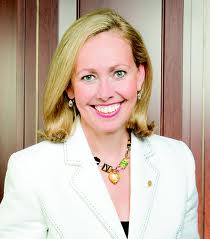Desjardins Group and its dynamic CEO have seized the moment.
The time for cooperatives is now.
Now when credit gridlock and near collapse of the global financial network are still vivid in memory. Now when fears and passions bring people to march the highways, camp in tents in public squares and go hungry to get a meeting.
Now, when the powers that be and people in the street could use good news about sustainable development on a sustainable planet, now is the time to press for cooperative economic and social enterprise.
Desjardins isn’t waiting. Canada’s largest member-owned credit union and the biggest financial institution in the country after the Big Five banks is emerging from its large and solid base in Québec to launch itself into the fastest growing markets in the rest of Canada and onto the main stage of the global cooperative movement.
Monique Leroux is determined to position co-ops front and centre when new and improved ways to manage the economic system are being decided. “What the cooperative model brings is really a connection of people and the economy,” she says. “The cooperative model emphasizes the importance of the equilibrium between human capital and financial capital.”
Reappointed last March to a second four year term as Desjardins’ chair, president and CEO, Ms. Leroux came to the top job at Canada’s largest co-op shortly before Lehman Brothers filed the biggest bankruptcy in history. What followed was the global financial crisis of 2008, big bank bailouts, deep and prolonged recession, car company rescues, soaring American joblessness and Europe’s sovereign-debt crisis. 
Through these serial overlapping cataclysms Ms. Leroux, a management black belt disguised as tinkerbell, steered Desjardins with sure and steady focus. Total revenues rose from $8 billion in 2008 to $13 billion in 2011. Assets on her watch grew from $152 billion to $190 billion. Pre-tax operating income soared to $2 billion from a scant $186 million in 2008 when Desjardins had to write off more than a billion dollars of debt acquired prior to Ms. Leroux’s ascension to the top job. Now, with the company on course, she’s got a second wind. First she’ll take Alberta. Then she’ll take the world.
Always up for a challenge, Ms. Leroux thought she might be a concert pianist, studied at the Conservatoire de musique du Québec while growing up in a suburb of Montréal, but switched to business, became an accountant, the first female consulting partner at Ernst & Young, VP at the Royal Bank, and had a stint at troubled printing and media giant Quebecor, before joining Desjardins in 2001. She’s hovering just under 60 but appears closer to 40.
In her expansionist ambitions she channels the company founder, whom she captured in a compilation of quotes and thoughts published last year as Alphonse Desjardins: A Vision for Today’s World. The company has never been a stay-at-home. In over a century of operation, starting as a small credit union (caisse populaire) in Lévis, across the river from Quebec City, it has assembled several outposts away from its provincial core, mostly to serve communities with significant French Canadian populations in Manitoba, New Brunswick and Ontario, but also in New England. In 1908 Alphonse Desjardins himself formed the first credit union in Ottawa, where he worked for a quarter century at the House of Commons. He helped draft legislation governing co-ops in Massachusetts and New York, was invited to a co-op conference in Washington by President Taft and is generally acknowledged to be the founding father of the North American credit union movement. The company has three branches in Florida today to serve Quebec’s snowbirds. Most of these initiatives have been relatively easy targets of opportunity primarily serving francophones.
Further afield Desjardins has a distinguished forty year history as one of the world’s leading microfinance providers. It anchors a network of microcredit unions operating in 2,500 locations in 30 developing nations. With a modest budget of about $20 million annually, it oversees a structure serving some nine million clients with total deposits of about $2.5 billion and total loans outstanding about the same amount. The average loan is for just over $500. This is not a business. It’s an NGO and its culture is different. Its funding is different, arriving from CIDA and other aid agencies. It’s different from Desjardins, but not unconnected. The substantial commitment Desjardins makes to community and social development is not unconnected to its long range development objectives.
The Blueprint for a cooperative decade that the International Cooperative Alliance (ICA) delivered at a United Nations ceremony in New York late last year challenges co-ops to become “the fastest growing form of enterprise” by 2020. Ms. Leroux was there to brief the UN on how the International Year of Cooperatives (IYC) had gone. She had much to do with IYC in 2012 and with kicking off the “cooperative decade” running to 2020.
“At Desjardins,” she says, “we are committed to creating new ways to spur growth and innovation every day to aid the development of the cooperative movement.”

Stéphane Bertrand
In fact Desjardins is taking one of the seven basic principles of cooperation to a higher level. That would be Principle Six, Cooperation among cooperatives. “Cooperatives serve their members most effectively and strengthen the cooperative movement,” says the principle, “by working together through local, regional, national and international structures.” Desjardins is emerging as the most cooperative co-op anywhere. It designed and delivered one of the peak performances of IYC, the International Summit of Cooperatives in Québec City in October 2012. It’s said this conference cost $10 million to produce, a number the company concedes is in the ballpark. Even with the $1 million sponsorship cheque presented by the feds with much fanfare, another $1 million from the province, counting minor sponsorships and revenue from ads and showcases and assuming that a good slice of the 2,800 participants paid full entry of $1,700, there’d still be a significant shortfall. Not only did Desjardins suck that up, it’s expected to do it again in 2014. At a board meeting during its AGM at Manchester late last year, ICA endorsed the repeat summit and reported that “Desjardins is moving forward positively on a follow-on in Québec City in October 2014.” It’s not farfetched to suggest that a successful second Summit has potential to develop into a biennial world leadership forum, a Davos for co-ops in Québec’s capital, a stone’s throw from where the movement had a start in Canada and historic birthplace of the nation itself. If the reality comes anywhere near the vision, it may be a sound investment indeed.
At the UN’s IYC closer, ICA presented two documents. The first is the co-op decade “Blueprint” with its ambitious plan for the co-op business model to become the “acknowledged leader in economic, social and environmental sustainability (and) the model preferred by people,” as well as the fastest growing, by 2020. Dame Pauline Green, president of Geneva-based ICA, chaired a five person work group to help prepare this seminal document. A member of the group was Stéphane Bertrand from Desjardins, who also serves as executive director of the Cooperative Summit.
The second document presented to the UN was the World Cooperative Monitor, a fresh cut at statistical analysis that reveals the largest 300 co-ops in the world have a joint annual “turnover” of $2 trillion (Desjardins is the largest of a handful on the list from Canada). That’s about 20% higher than Canada’s annual GDP. On the international steering committee for the Monitor, which is being produced in Italy, is Éliane O’Shaughnessy from Desjardins, who is “strategic advisor” in Ms. Leroux’s office.

Eliane O’Shaughnessy
There’s no doubt that Desjardins is finding distant shores appealing. It has established a €5 billion bond program to “implement liquidity and asset management strategies and diversify capital sources” and last year issued US$1.5 billion of covered bonds, only the second time it has issued bonds in the United States. The company is proud and protective of its admirable capitalization, anchored by member commitments, that provides a ratio of 19% overall of which by far the most (16.5%) is Tier 1 (long term) capital. These are far better ratios than prevail at the Big Five and place Desjardins in the top score of best capitalized financial institutions globally.
Overseas, it has entered an agreement with Crédit Mutuel, a financial co-op about twice its size in France. This foothold in the European market, which Ms. Leroux pledged to follow up as one of the priorities of her second term in office, has begun with a $50 million investment in a new high tech VC fund that is expected to grow in the near future as new partners sign on. Apart from joint ventures, the arrangement contemplates mutual accommodation for Crédit Mutuel’s members (‘clients’ to conventional banks) with needs in Canada and Desjardins’ members with needs in Europe. Desjardins also opened an office in Paris a year ago.
It’s clear that cooperating with cooperators can pay off internationally. Ms. Leroux owned the podium at the Summit in Quebec City, at ICA’s AGM in Manchester and at the IYC presentations at the UN in New York. The co-op world is paying attention, which can’t be anything but good for Desjardins because of that sixth principle. When the like of Crédit Mutuel are looking for compatible partners in Canada the big green D is hard to miss.
And what about those parts of Canada where the culture is different and the other official language prevails? Ms. Leroux has already spent not far off a half billion dollars ($443 million) to buy Western Financial Group based in Joe Clark’s home town of High River, Alberta, telling one reporter, “we want to continue to expand slowly but surely . . . across the country.” Western Financial isn’t a bad starting point. The group provides financial services but the bulk of its business is insurance. In this respect it’s square into territory Desjardins mastered long ago, the merging of banking and insurance. More than 40% of Desjardins’ income flows from life, health and property insurance premiums, business permitted them by provincial charter but long denied and still restricted to federally incorporated banks. Western Financial is the largest property and casualty insurance brokerage in western Canada with half a million clients and a fistful of offshoots, including “Canada’s oldest and largest pet insurance provider.”
Western Financial is not a co-op but a strategic investment that gives Desjardins a lookout on the territory. It doesn’t replace the continuing application of Principle Six. In that regard Ms. O’Shaugnessy says, “It’s the beginning of something, not the end. The west is definitely the main growth market in Canada. We’re very active in the region developing partnerships with established credit unions.”
Because of its origins and growth pattern, Desjardins is not nearly as well connected to the co-op sector in English Canada as it is in Québec. Its basic community and culture are Québecois. However the company operates bilingually in many English-speaking centres. And it’s about to enhance its position nationally. Ms. Leroux and team are key participants in current negotiations to integrate the Canadian Cooperative Association (CCA) with Conseil canadien de la coopération et de la mutualité (CCCM). It’s hoped to bring a proposal this summer to the AGMs of both associations to form a unified nationwide agency that will support and speak for co-ops of all kinds in both official languages. The traditional two Canadian solitudes have already begun to merge operations, sharing office space in Ottawa and convening joint annual conferences. Desjardins, which has not been a member of either but is a “sponsor” of CCCM, intends to be a more prominent player in the new entity it is helping to design. A VP and staff of a half dozen already provide advice and assistance for cooperatives on governance and development.
Clearly, if a biennial summit of global co-op leaders is established in Québec City, which appears likely, and if Desjardins continues to pay the piper, the influence of the company on the movement is set to grow big time. And if the movement’s business leaders such as Ms. Leroux succeed in making cooperatives the fastest growing form of enterprise by 2020, look out Big Five, the big green D has you in its sights.
But odd as it may seem to those who appreciate their business skill, beating the Big Five isn’t what turns the crank at Desjardins. It’s hard to say which of the seven co-op principles they take most to heart there. The principles are identical to those that guide development in 750,000 co-op businesses worldwide with a hundred million employees serving a billion members. It may be Principle Seven, Concern for community. “Cooperatives work for the sustainable development of their communities,” the explanatory text reads, “through policies approved by their members.” Sustainable is the operative word here. Sustainable businesses. Sustainable livelihoods. Sustainable environments.
Now. It actually may be the case that now is the time for all movements of conscience and concern and cooperative enterprise to be idle no more. Let a thousand initiatives flourish in as many different ways. For most things, though, from hospital budgets to filling the gas tank to payscales for the working poor, it’s still and always will be about the economy.
Pollution will be tackled by pricing carbon, among other economic models. Energy will be driven more and more to renewable. Social and environmental impacts will be added to financial statements. First nations people will find opportunities in development partnerships based on trust and fair practice. Immigrants will get credit for their training and experience and the help they need to find their way. Schools and tools for young people will be abundant. Desjardins and other co-ops believe these are the things a sustainable economy promises and can provide.
They believe it because cooperatives are the most sustainable of known economic alternatives. It’s a fact. “The survival rate of co-ops is higher than that of private sector companies,” says Ottawa’s Cooperatives Secretariat. “A 2008 study in Quebec found that 62% per cent of new co-ops are still operating after 10 years, compared with 44% for other traditional businesses/corporations.”
At a century-plus and not slowing, Desjardins is a model of sustainability. How that model influences the co-op movement and the way we do business in Canada and abroad will be playing out in Québec City about a year and a half from now. After the $10 million opening extravaganza that grabbed rave reviews and a 90%+ approval rating from goers last year, Act II of the Summit is likely to be something special and, for Ms. Leroux, far from a fond farewell.
